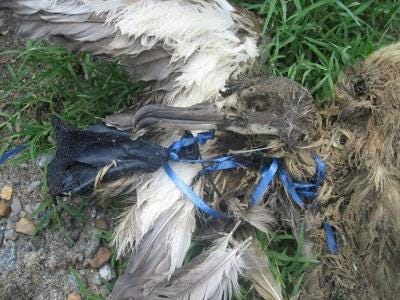Balloons Sent Heavenward Create Hell on Earth for Wildlife
Ted Williams
Jul 2, 2025
Releasing helium-filled balloons in celebration, remembrance or promotion has become trendy over the past four decades. It’s a dangerous practice, born of ignorance and bereft of justification.
Last Memorial Day a balloon release was held in Upper Darby, PA for a murdered 16-year-old boy. And on June 17th a balloon release was held in Ridley Township, PA for a 12-year-old girl who died in a scooter accident.
It seems unlikely that the families would have agreed to such commemorations had they understood the consequences.
"When released, [balloons] often travel long distances before landing in various ecosystems, where they become hazardous litter,” explains Sen. Amanda Cappelletti (D-Delaware County), sponsor of SB879 to ban balloon releases. “Balloons can take years to decompose and frequently pose dangers to wildlife, which may mistake them for food, leading to ingestion, entanglement, and often death.”
As a hunter and angler, I see the toll this litter takes. Birds, reptiles, amphibians, terrestrial and marine mammals get entangled in balloons and their attached strings, then die slowly and painfully. As sportsmen, we promote stewardship of land and water. Balloon releases make a mockery of this ethic.
Even balloons released in mid-America easily reach saltwater. According to the journal Scientific Reports, balloons kill 20 percent of seabirds that ingest them, and birds with balloon material in their digestive tracts are 32 times more likely to die than birds that have ingested other types of plastic.
The Institute of Marine and Antarctic Studies found balloon parts in about one in every 20 seabirds it examined.
All sea turtles eat jellyfish. Deflated balloons mimic jellyfish and fatally clog sea turtle guts. The critically endangered leatherback sea turtle feeds almost exclusively on jellyfish.
Marine mammals ingest balloons, dying as a result. Even whales aren’t safe. A necropsy of an extremely rare Gervais’ beaked whale stranded on a North Carolina beach in 2023 revealed a balloon that had obstructed its digestive tract, causing the animal to starve to death.
Most balloons are made of plastic. As they break down, they release microplastics into seas, lakes, rivers and drinking water supplies. Microplastics are endocrine disruptors that can cause cancer, disable immune function and stunt growth. They’re consumed by zooplankton, moving up food chains, eventually to humans.
Some released balloons are made of Mylar. Their metal coating conducts electricity, causing outages or fires or both when they fetch up against powerlines.
The extent of balloon pollution on land and water is appalling. For instance, the Alliance for the Great Lakes has removed 118,887 balloons from shorelines over the past 20 years.
In 1985, to celebrate the 30th anniversary of Disneyland and Walt Disney’s 84th birthday, the City of Anaheim, California, organized a million-balloon release called “Skyfest.” It made the Guinness Book of World Records, doubling the record set the previous year in Japan.
Not to be outdone, United Way organized “Balloonfest ‘86” in Cleveland, Ohio in which 1.5 million balloons were sent aloft. Promptly flung to earth by a weather front, they festooned the city with plastic, causing motor vehicle accidents, injuring horses, blocking air traffic, and hindering Coast Guard rescue operations on Lake Erie.
As a result, the Guinness Book of World Records now declines to recognize balloon releases.
Balloon releases are also a wanton waste of helium, now in short supply globally and essential for magnetic resonance imaging. To cool its magnets, a single MRI machine needs 37,400 pounds of liquid helium over its lifetime. And creating one pound of liquid helium requires 97 cubic feet of gaseous helium.
Until 2021, Russia supplied a third of the world’s helium. Putin’s invasion of Ukraine stopped trade.
Dr. Scott Reeder, chief of MRI at the University of Wisconsin School of Medicine and Public Health, reports that the helium shortage is so acute that new MRI machines can’t be set up.
SB879 provides an opportunity for Pennsylvanians to do better. Protecting wildlife and wild places is not a partisan issue but a shared responsibility. That’s why SB879 is supported by a broad coalition that includes hunters, anglers, animal advocates, environmentalists and farmers.
California, Rhode Island, Virginia, Massachusetts, Delaware, Hawaii, New Hampshire, and New York have banned balloon releases. It’s time for Pennsylvania to follow suit.
Ted Williams writes about fish and wildlife. He has hunted and fished extensively in Pennsylvania.




